Portrait of an Electron Tube
D3a
This tube is one of the last German post tubes for Audio purposes, of which C3o, C3g, C3m, and D3a were the highlights. (C3o is a C3m with 6.3V heater)
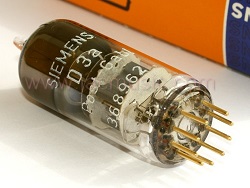 It can be used as pentode or in triode mode. It is a triple Mica tube, for low noise and good shock resistance. Pins are very thick plated with 24k gold. With a broken tube, I checked this, you can really scrape off gold flakes with a knife. Crazy but true! This is a FRAME GRID pentode, which is extremely rare with tubes. Only 80 or so, frame grid tube types were ever designed. It can be used it as a very high gain pentode, ideal for Moving Coil amplifier, or other applications that need low noise. Yet it can do high voltage as well. I have even seen it as current source in a mu stage, very successfully.
It can be used as pentode or in triode mode. It is a triple Mica tube, for low noise and good shock resistance. Pins are very thick plated with 24k gold. With a broken tube, I checked this, you can really scrape off gold flakes with a knife. Crazy but true! This is a FRAME GRID pentode, which is extremely rare with tubes. Only 80 or so, frame grid tube types were ever designed. It can be used it as a very high gain pentode, ideal for Moving Coil amplifier, or other applications that need low noise. Yet it can do high voltage as well. I have even seen it as current source in a mu stage, very successfully.
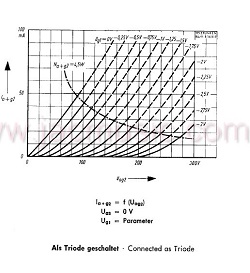 Triode Mode. Same as C3g-C3m, the D3a tube has such excellent Triode Mode curves. Linearity is outperforming such a classical tube like the 12AX7 ba far. Yet 12AX7 is already very linear. But who has tried, will knpw 12AX7 can not be used as a drver tube, because output signal can hardly be loaded. Any load om 12AX7 will reduce the gain quickly down to 65x, then give distortion, and at smallest capacitive load with 12AX7 will give high frequency roll off. Not so with D3a. Impedance is amazing 1.9k only, meaining gain of 77x does not collapse and it can easily drive grid capacitance of outout tubes. So yes, the question: What do youwant... Gain or low impedance... can now be answered with: BOTH! This is why so many people love this tube. The Russians have something a little bit in this direction, called 6C45. But this is a high frequency tube, not intended for audio. It has no good linearity, designed for smaller signal swing. Most of all at high signal swing it becomes a distortion generator. 6C45 tends to oscillate unexpected, they often develop a crack noise after use, they have short lifetime, and gain is lower. Besides 6C45 has a TERRIBLE spread of data. What does this mean? You can not work well without selecting them in pairs, but if you try to select them, you will have a hard time doing it. That is why high spread of data is a "no no" for audio tubes. Because of bad factory quality, and many problems my custumers had, I have stopped selling 6C45, because it is just not an audio tube. No, if you want a tube like D3a, there is little alternative.
Triode Mode. Same as C3g-C3m, the D3a tube has such excellent Triode Mode curves. Linearity is outperforming such a classical tube like the 12AX7 ba far. Yet 12AX7 is already very linear. But who has tried, will knpw 12AX7 can not be used as a drver tube, because output signal can hardly be loaded. Any load om 12AX7 will reduce the gain quickly down to 65x, then give distortion, and at smallest capacitive load with 12AX7 will give high frequency roll off. Not so with D3a. Impedance is amazing 1.9k only, meaining gain of 77x does not collapse and it can easily drive grid capacitance of outout tubes. So yes, the question: What do youwant... Gain or low impedance... can now be answered with: BOTH! This is why so many people love this tube. The Russians have something a little bit in this direction, called 6C45. But this is a high frequency tube, not intended for audio. It has no good linearity, designed for smaller signal swing. Most of all at high signal swing it becomes a distortion generator. 6C45 tends to oscillate unexpected, they often develop a crack noise after use, they have short lifetime, and gain is lower. Besides 6C45 has a TERRIBLE spread of data. What does this mean? You can not work well without selecting them in pairs, but if you try to select them, you will have a hard time doing it. That is why high spread of data is a "no no" for audio tubes. Because of bad factory quality, and many problems my custumers had, I have stopped selling 6C45, because it is just not an audio tube. No, if you want a tube like D3a, there is little alternative.
Pentode Mode. This is nothing wrong of course with the pentode mode as well. In pentode mode, the gain of the circuit is determined only by the external components, and not by the tube any more. So a circuit with low gain may as well be designed, and on accordance with electronics theory, such a circuit will have accordingly low noise and low output impedance.
External Link to D3A datasheets
Ultra Linear mode. This combines the advantages of triode mode and pentode mode. Often forgotten is a major advantage you can not damage the screen grid, and also don't need to bother with setting the screen grid voltage. Another way to look at this, is there is signal feedback from the anode to g2. This is mainly giving triode sound but keeping some of the pentode goodies, such as less sensitivity to power supply hum. Ultra linear mode is conveniently possible with the Lundahl inter stage transformer like LL1660 and it's family members. if you don't like an inter stage transformer, ultra linear can be achieved with any of the Lundahl plate chokes, since these are always made of two coils in series, and there is always s 50% tap available. A good ultra linear circuit works from anywhere from 1/3 to a 2/3 tap.
External Link to D3A datasheets
Frame grid. D3a is a so called frame grid tube. In the article about E83CC, there is a lot of information about this. A frame grid is a rectangular hard metal frame, around which the the grid wire is wound under tension. So with a regular grid, the grid wires are NOT wired under tension and are even used (rather abused....) to hold the grid together. With a frame grid, there is no longer this mechanical need for the grid wires to hold the grid together, so the wires can be made much thinner. Note, transconductance is given by the wire thickness and the wire spacing. So the thinner the wire is, and the smaller the spacing, the higher the transconductance. The grid wire of D3a is so amazingly thin, it can not be seen with the naked eye any more. So looking at a grid, removed from an old tube, you can see through of course, but it looks like a mildly opaque surface. Same is like a transparent plastic bag.
Transconductance. The frame grid does it's work and transconductance is is the amazing range of 33mA/Volt or 33.000 microMho for American users.
Microphonics. Since the frame grid can be attached more tightly to the mica (there is no risk to warp it) microphonics will be lower. Where it has to be said, microphonics in general also greatly depends on the electrical circuit, so not only on the tube.
The situation with old stock. It appears that appr. 5% of NOS stock has a large crack in the glass base, which is immediately visible as such, and also the getter has become white. We just want to mention this here. This is a yes/no situation, and the tubes that are good, are simply good, and do not crack the base. A similar situation I observed with larger stocks of 6SN7 as they were still available in the 1980's. Normally, tube dealers sort these out.
Some 2...20 hours of Burn in, with an AUTO BIAS circuits is need, in order to bring down the g1 leakage below the data sheets lower value limit. So this is either done by simply using the tube, or by burn in, prior to testing. So if NOS tubes, right out if the box seem to exceed g1 leakage, this has initially no meaning. Yet it has to be said such tubes do represent final bias data, so longer burn in is not just an option prior to final testing, it is a requirement. It just shows how delicate such very high Gm tubes can be.
Factory test data of D3a
This is a very comfortable situation, because D3a is similarly precise specified as the older C3g-C3m. Meaning the data sheet has pentode data and triode mode data, and a third table of data there is TEST data, with minimum and maximum acceptance levels for NEW tubes, and also End-of-Life data for use tubes. So this is in sharp contrast with commercial tubes, which only have "average" data, missing information for acceptance level testing, and expecting end-of-life data is a joke. This extremely precise data as the D3a data sheet specifies, already shows what a quality product we have here.
Testing auto bias or adjustable bias. There is great lacking knowledge with almost every user of tube equipment about how to test tubes for quality.
Tubes should be matched in what is called an adjustable bias circuit, AND should be matched only after thermal balance. So that is when the anode had reached it's final temperature, and final mechanical shape under working temperature. This will take 5...10 minutes. This is why simple "impulse testers" like e-tracer or utrace can not be used for this, because these only heat up the cathode, but not the anode. Errors resulting from this can be 1...20% with plate current, and moreover leakage data becomes virtually invalid with impulse testers, as leakage only appears at highest temperature.
Everybody can match as he likes, and pick out tubes his own way, but here is how we recommend it: Since D3a has a very high transconductance, so a high change of Anode current, caused by a small change of grid voltage, matching should be done at the SAME plate current, and make sure that tubes of comparable grid voltage and comparable transconductance are paired.
A typically WRONG way to match D3a, would be to use a fixed grid voltage and then match by the resulting plate current. Such an incredible high Gm tube like D3a will show almost crazy variations in plate current this way, and the question should be asked, what one is trying to prove or achieve with this. So this method would be totally wrong and silly, because the tubes are testing by Gm now at some very "random" plate current, and not at the manufacturer's test point of 22mA.
Tubes should be tested for quality only in an auto bias circuit. Such a circuit should represent a relatively hard condition for the tube, which is usually at not too high voltage, and relatively high current. Then in case a tube becomes weak, this will eventually become a problem for it's major function: The GAIN. The clue with auto bias (under relatively hard condition) is, the tube will not draw full current any more. This is because the gain has gone down, and the auto biasing system begins to fail. Then, at lower current, there will be even lower gain, etc. So the whole situation with an auto bias circuit collapses, when a tube begins to get weak. Simply it can be said, if the tube will not auto-bias correct any more, it has failed this test. The only thing the user would need for this, is the auto bias circuit manufacturer has used, and of course the acceptance levels of plate current and transconductance belonging to it. There is always a cloud of smoke blown around this subject, by the manufacturers, but not so with D3a! So they specify the auto bias circuit for testing, what are the acceptance levels for a new, out-of-the-box tube with this circuit, and what are the rejection levels for used tubes.
. 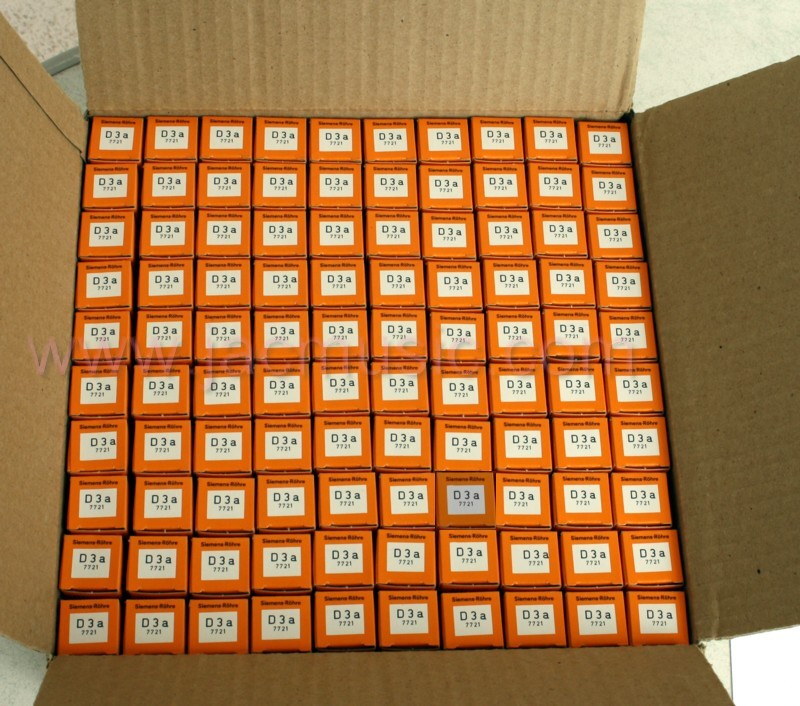
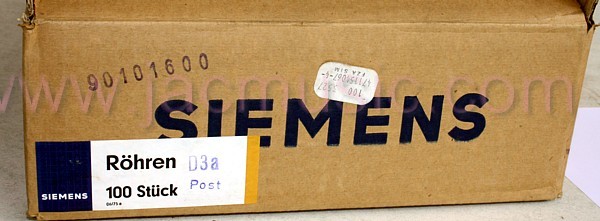

This sticker was on the above box.
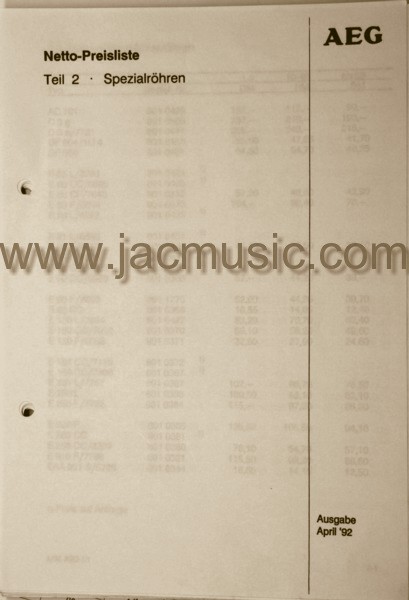
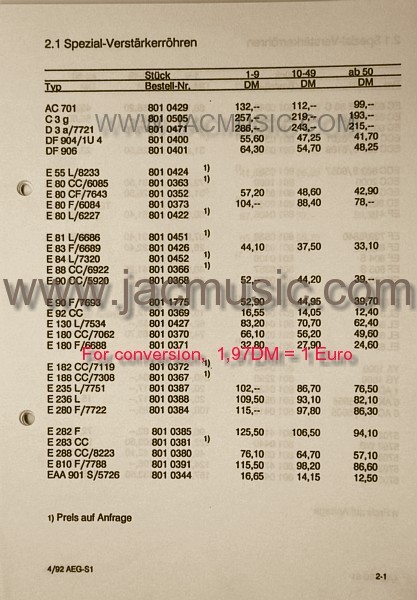
I have an original old pricelist. D3a had a factory price of 286DM one in 1992. That was 145 Euro in 1992, but with 30 years of 5% inflation on it, (1.05^30) that would equal 626 Euro today. This price is not a joke! The factory was AEG Telefunken, and production was for Siemens. It was the most expensive small signal tube they had in the program.